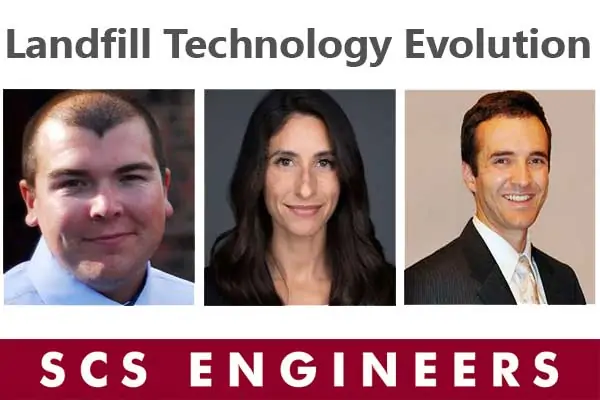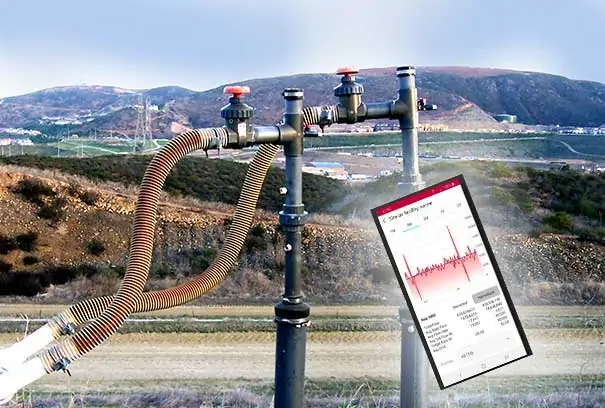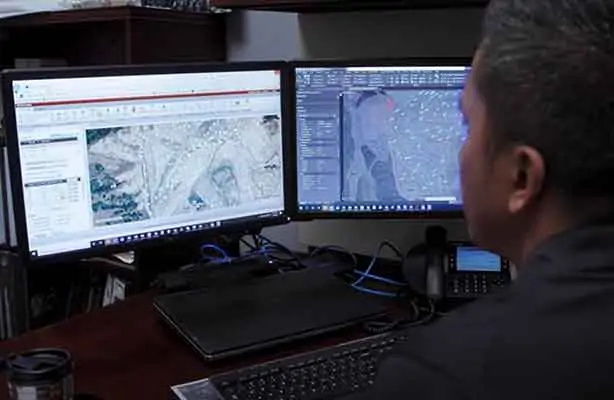


Our industry is in a period of a rapid transition to digital data management, but particularly on landfills. Often you read that the latest technology, whether by a brilliant programmer or rolling out as part of a takeover, is innovative. Linking technology and innovation is becoming commonplace, but they are not the same. Innovation is a human process requiring experimentation and iteration to solve landfill issues that often have nothing to do with computers or mobile phones. Landfill technology or apps are tools.
Innovation takes a team of diverse expertise, different perspectives with a constant desire to learn, and most importantly, the primary desire to make landfill operations more efficient and safe. Innovators use technology when and how it makes sense to improve environmental management, profitability, and care for employees and the local community. Lower cost solutions for the vast amount of data collection completed faster and without human error come from people with hands-on in-the-field experience. When it comes to landfill technology, its value is clear when a landfill practitioner demonstrates how the particular technology fits into a solution. The nice part is they also get to the point and skip the tech-speak and jargon.
The Landfill Technology Evolution Started Here in 2003
Back in 2003, SCS couldn’t find technology that would enable our engineers and technicians to support landfill operations as we desired. Proving the proverb “necessity is the mother of invention,” we developed a database for our use. Its value in the field was immediate, and SCS continued to adapt and develop SCS DataServices® and SCS MobileTools®, basing refinements on each landfill and client need. It took people in the waste industry to make the right technology tools for the industry.

Meet Oliver Early, SCS’s DataServices and MobileTools Product Manager. Oliver started his career managing landfill operations. He became interested in technology because it got results for him as a landfill manager of 15 facilities. By combining a comprehensive investigation of physical landfill systems, such as landfill gas collection and control and other environmental monitoring and control systems with evaluations of compliance areas, he improved his landfill system performance and substantially increased power plant production. He used multivariate data techniques, including time series and network analysis, to scrutinize and refine results. Merging DataServices capabilities under Oliver’s guidance took SCS’s original internal database to a timesaving product for all landfills, not just the landfills SCS operates.
The platform, called SCS eTools®, includes modules for leachate, groundwater, DataServices, and the newest application SCS MobileTools, free for those using DataServices. The technology is currently in use on over 630 landfills nationwide and benefits all of SCS’s design, build, and operations work.
For example, if methane readings at a gas probe are elevated, that’s an indication of a potential LFG migration issue. While expertise is great – it could take hours to diagnose and mitigate. With DataServices, you could run an evaluation of the existing well field in a few minutes, ruling out issues with current wells. With the touch of a button, you can share the information with your team and focus on potential mitigation recommendations.
Remote Monitoring and Control Technology Didn’t Happen Overnight Either
The best and most innovative solutions come from combining the stakeholders’ experiences and thoughts. Let’s meet a few of the people who lead other landfill innovations.

In addition to being a licensed drone pilot herself, flying over 100 landfills, Business Manager Melissa Russo uses SCS Remote Monitoring and Control (RMC) technology to support her landfill clients. Her contributions increase safety and lower environmental risk using unmanned aerial vehicles to gather field data at a lower cost. Melissa developed SCS’s national drone and geographic information systems (GIS) programs to respond to her clients’ needs for expensive regulatory and operating challenges. As a result, capturing more (methane) greenhouse gas instead of releasing it into the atmosphere provides the obvious environmental benefits, and landfill personnel have better and safer working conditions.
Depending on the sensor or camera attached, her pilots can monitor methane concentrations using a tunable diode laser, measure and map surface temperatures to mitigate elevated temperature conditions, or create topography, aerial imagery, and estimate filling volumes. Operators can view, detect and measure changes over time, gaining insight into critical infrastructures such as water infiltration, liquid flow, and vegetation distributions. Melissa’s use of GIS provides a low-cost solution to data management and sharing between field and office.
Melissa is an innovator who genuinely cares about our industry, taking the time to listen and truly understand her clients’ challenges and long-term goals. Only then does she devise customized solutions, regardless of whether it uses technology or not. See Melissa at work.
The Internet of Things (IoT) is Bang for Your Buck

SCS RMC’s Business Manager is David Hostetter. His experience includes remote monitoring and controls systems engineering, construction, and operation; landfill gas and leachate engineering; and mechanical engineering. Dave’s focus is on automating remote process control of landfill systems, landfill gas blower/flare stations, wellfield vacuum and flow, along with leachate and groundwater pumping systems, weather equipment, and air monitors.
As a landfill gas engineer, his impetus was to avoid production downtime and keep operations within regulatory mandates. He wanted his clients to see what was happening at any given time and be alerted to atypical conditions. As a landfill engineer, he knows that “prevention is better than cure,” as long as it’s cost-effective. Dave’s solution is to leverage the Internet of Things through SCS RMC systems. Each piece of equipment you want to monitor gets a sensor. His team configures each sensor or group of sensors to parameters based on his operator’s business needs and environmental reporting responsibilities. A local wireless network communicates with a base station providing continuous readings from each sensor.
RMC sends alerts if readings are outside an acceptable range or if an environmental threshold is nearing exceedance. Alerts go to the landfill’s designated staff or technicians via smartphones, computers, or tablets. From these devices, users access their interface to control, start, stop, and reset field systems and analyze system operation. They can also view data, graphs, tables, alarms, and reports.
That’s more than convenience; it saves labor dollars spent to diagnose and reset these systems and is especially valuable for remote landfills. By design, clients can enable custom authorization levels for their systems. Naturally, the analytical tools are easy to use, understand, and report, as he explains in his video.
Albert Einstein Said…
“You can’t solve a problem on the same level that it was created. You have to rise above it to the next level.” We’re not comparing ourselves to Einstein, but all three SCSers leading their teams know that compliance policy never stops changing, and landfills are unique beasts made up of complex systems that need balance to perform. Performance is based on daily decisions and landfill readings generating enormous amounts of data. SCS’s job is to make your job better by collecting those millions of data bits for analysis faster, helping landfill operators use the intelligence to identify the cause and appropriate response to hundreds of issues that are part of landfill or facility management.
The backbone of every service at SCS Engineers is to design and develop based on our clients’ specific needs. As innovators, our mission is to leverage proven technology to meet those needs. As our founders did, we strive to understand our clients’ current and future needs, then develop or integrate the appropriate technology to meet those needs.
SCS is one of the most experienced and successful environmental compliance, design-build, operations, and maintenance firms in the United States. No stand-alone technology company can substitute for our knowledge and hands-on experience with innovative landfill design, build, and operations.
Visit SCS Engineers to discover SCS eTools and SCS RMC capabilities. You’ll find case studies, technology awards, and more resources for using technology to manage labor, liquids, air monitoring, groundwater, volume, GHGs, and more

A two-part interview with Landfill & LFG Engineer Sol Sim, Product and SCS Field Services Manager Oliver Early, and Software Developer Brooks Ballentine.
As technology advances to optimize landfill operations and ensure compliance, so does the amount and type of data available to support operators in making informed decisions.
The industry is adding more and more data points to fill in the story of a landfill’s health, driving this demand for ‘big data,’ delivered in real-time. Sprouting alongside this big data trend is another one: employers rely less on laptops and more on mobile devices, and they expect those devices to have sophisticated functionality.
In response, SCS Engineers launched SCS MobileTools®. This powerful app is the latest addition to SCSeTools®, a platform created to standardize data acquisition, optimize data use, and ensure that data is secure.
Watching in Real-Time
MobileTools enables field workers to pull up data on their iOS or Android mobile devices and observe real-time activity through a secure, wireless connection. It means they no longer have to connect instruments to their laptops and forward files to another source for upload to the eTools platform.
Instead, data goes from users’ smart devices to the cloud, enabling field workers, as well as operators and other decision-makers who work remotely, to access that information immediately.
“MobileTools builds on SCSeTools, which constantly takes in data and validates, analyzes, displays, and reports on that data. We realized that by incorporating technologies we’ve already built into this platform into the mobile devices, existing data acquisition workflows could be enhanced,” says Brooks Ballentine, SCS director of Software Development. “The result reduces effort and costs while increasing accuracy.”
“We’ve added wireless data transfer to MobileTools because the ability to access information within 24 hours is not good enough. We want to be within minutes to catch exceedances immediately,” says SCS engineer Sol Sim, who manages clients’ landfill gas operations.
“This is a real-time upload. So, if technicians are out in the field collecting data and a well has an exceedance, they can send a notice. If corrective action is required, the tech is already there to take that action,” he says.
Keeping Tabs on Flares
MobileTools is equally instrumental in keeping close tabs on flare activity, capturing information to identify overall flow trends, and ensuring the system meets stringent compliance requirements.
“Each flare has a data logger that records regulated parameters, such as gas flow and temperature. Data is stored minute-by-minute on the logger and typically requires an extensive manual process or expensive and complicated networked solutions to aggregate data in a centralized data repository. With MobileTools, this same data is transmitted in a simple process using existing mobile devices,” says Oliver Early, the product manager of SCSeTools-DataServices.
Early’s story around SCSeTools began in 2008. At the time, he was a client of SCS, paying to use the app to support a landfill gas-to-energy developer in ensuring regulatory compliance.
“I joined SCS in 2013 to come up with more features and push the app forward with new ideas and new ways of doing things, with wireless data transmission being the most recent advance,” he says.
Users of MobileTools can interact with site-specific data such as exceedance metrics for landfill gas, liquid levels, and surface emissions. And they access touch-enabled data charting to review daily gas loads recorded by flares.
MobileTools has the ability to attach photos to provide supporting visuals for more information and or to put data in context. This facilitates communication between field technicians, site managers, and corporate management, who can get a more tangible “picture” of what’s going on in the field.
As with every feature in the eTools suite, MobileTools is designed with data integrity and security in mind.
In the case of landfill operations monitoring data currently collected by hand, MobileTools will digitize the process, allowing for faster acquisition and near real-time analysis.
Integrating More and Different Data – Validation
“We are integrating data in MobileTools that is not currently collected on standardized instruments, such as liquid levels and pump cycle counts.
“So, with monitoring data that was recorded on paper, then entered into spreadsheets, techs now type it directly into the device. It is validated and then uploaded,” Ballentine says.
These and other features and functions are designed to be time and money savers. Field workers who now have a streamlined protocol can accomplish more in a day, freeing themselves for maintenance projects and other tasks. Operators can rely less on consultants to review data and identify potential issues or needed improvements.
Sim is part of the team involved in further developing and testing SCSeTools. That landfill practitioners developed the platform for landfill practitioners is key to its effectiveness, he surmises.
“We are not a software company dabbling in landfills; we are landfill operators. We know the industry, as well as the functionality needed in landfill software.
“Field engineers, staff, and technicians have been asking for a mobile app for some time. The ability to have data at our fingertips in the field is a tremendous tool for quickly troubleshooting issues,” Sim says.
Part I of the Interview Series

A two-part interview with Landfill & LFG Engineer Sol Sim, Product and SCS Field Services Manager Oliver Early, and Software Developer Brooks Ballentine.
Back in the day, environmental engineers and landfill operators had to create their own spreadsheets to track mountains of data, then try and figure out what all that data meant, a tedious process with limited functionality. But that’s changing, and SCSeTools® is at the forefront of the evolution. This powerful yet user-friendly digital platform automates data management; harnesses an ever-growing volume, type, and complexity of information; and expands on what solid waste professionals can do with that information.
Created by landfill practitioners, for landfill practitioners, SCSeTools collects, monitors, analyzes, and manages data on key landfill operations and assists in reporting. It’s leveraged by SCS staff and its clients nationwide to help facilitate sound operational and engineering decisions while saving time, labor, and money. Because operators get information in near-real time, they can act quickly and proactively should red flags spring up in their tightly regulated world.
The platform includes three modules: SCS DataServices®; SCS Groundwater™; SCS Leachate™; and the newest feature—SCS MobileTools®. Collectively these customizable toolsets have the flexibility to capture the big picture of a site’s overall health or zero in on what’s happening at a single gas wellhead, leachate collection sump, or other location. The modules’ design supports the smallest and largest sites and serves operators managing one, 10, or even hundreds of facilities.
From the Big Picture to the Fine Details
SCS DataServices is the flagship product and the one that SCS engineer Sol Sim uses most. This module captures and utilizes landfill gas facility monitoring and management data. It’s also designed to serve as a compliance reporting tool.
Sim likes to tap into the app to look through different lenses, depending on what he needs to see and understand.
“You can use SCS DataServices to get a broad overview of what is happening, but you can also drill down to see where you need to focus to ensure you are spending time and resources efficiently,” he says.
Being able to dissect large volumes of data quickly, then key into the finer details as needed has made his job easier. And he can work smarter and faster.
“Without this tool, it’s a bit of a needle in a haystack. But now, we can easily visualize and pick out relevant, near real-time data to assess performance. And when there are deficiencies, we can make adjustments promptly—maybe upgrade a wellhead or upgrade laterals to optimize gas production,” he says.
Connecting the Dots in a Visual Format
The GIS mapping function, a component of DataServices, has been one of Sim’s go-to tools. It provides data points for individual locations within a landfill system and helps connect the dots in a visual format.
“You have point references and can spatially display a lot of data at once so, unlike with a spreadsheet format, you can see and process where a well is in relation to others,” he says.
Custom mapping captures any parameter, whether data points around gas flow, header vacuum or gas quality. Ranges are set to identify trends and, ultimately, provide information to make more informed decisions.
This ability to spot trends or patterns is integrated into features beyond mapping. A built-in algorithm helps determine if a client’s operations are trending in the right direction, and that determination can be made as patterns unfold, which helps field staff stay on top of the curve.
“If changes occur slowly, it typically takes time to notice, but if you look at six months or more of data at a time, you see that 1 percent change in temperature or flow, for example, that has crept up incrementally. You have one visual snapshot that captures a lot of data fast. So, if there are issues, you can get to the route quickly and make adjustments practically in real-time,” Sim says.
The DataServices module has served well as a troubleshooting tool. Sim illustrates with a real-life scenario: a client whose landfill gas-to-energy project was grossly underperforming.
“They had data but no way to review it efficiently to try and understand what was happening. They were ready to bring in a new operator. We were able to come in; upload their data into our system; identify the problem; and make easy, relatively inexpensive upgrades that increased their gas extraction by close to 15 percent.”
Besides helping to realize direct dollar benefits, the tool can compute and outline deficiencies from a regulatory standpoint.
“Our client had outstanding past exceedances that had not been remedied properly. We helped them get back into compliance and mitigate potential future issues that could have resulted in fines,” Sim says.
When SCSeTools was created, the primary goals were to standardize data acquisition and ensure that the data was secure. It was used internally at first, at a few landfills. Clients began asking for it, and now the toolsets are leveraged at over 650 locations across the country, both by SCS and clients who operate their sites.
Ensuring Data Integrity – Simplifying Processes
It continues to evolve, with one of the early advances being encryption of data collected in the field, which means that it can’t be modified when transmitted to the app.
Before, there could be errors if a file was interrupted or data mishandled as it moved along the chain of custody, explains Oliver Early, the product manager of SCSeTools.
“And now we have taken the capabilities even further,” says Brooks Ballentine, SCS director of Software Development.
“Today, we are enhancing MobileTools so field technicians can enter and transmit data directly from their mobile device to SCSeTools. This not only ensures data integrity but simplifies the process,” he says.
Data integrity and ease were the front and center focuses while designing each feature and function. Another example of this is that the software enables gas measuring instruments to be configured to align with well configurations.
“Every gas well has a unique configuration, and they are often reconfigured. Because we can synchronize the configurations from eTools to each technician’s instrument, we end up with more accurate, consistent readings, when, before, that was impossible,” Early says.
Staying On Top of Timelines
Operators must stay on their game to keep up with regulated monitoring timelines, whether involving activity at wells, monitoring probes, or flares. Some sites have hundreds or even thousands of data points with individual data timelines and, what’s more, those timelines can change. DataServices, in particular, works to simplify the detail-heavy process. It supports operators in better managing prescribed monitoring events in a couple of ways: by enabling them to view data for a specific monitoring period and by allowing them to set events to align with mandated periods.
So, if systems were out of compliance and now have to be monitored more often, the frequency can be set accordingly.
In addition to DataServices, with its robust capabilities around managing landfill gas systems data, the SCSeTools suite features two more modules: the leachate and groundwater modules. These tools are designed to support processes established to ensure regulatory compliance, optimize operational efficiency, and save costs.
SCS Leachate provides relevant information to help determine the most efficient and economical leachate disposal methods. The app manages the input, analysis, review, and export of information such as leachate origin, volume of fluids, and sample lab results for specific collection points.
The module charts and graphs leachate data by disposal method and site or multiple sites. Then, it can determine trends in leachate disposal totals using established parameters associated with leachate management.
“Once all this data is gathered and logged, users can run reports and come up with disposal costs based on data provided by clients. We can track and trend how much operators are currently spending on leachate disposal to help them optimize liquid management and plan budgets for the next year,” Ballentine says.
SCS Groundwater tracks constituents to help manage water quality and to mitigate or remediate issues. It was developed to enhance operational efficiencies while also providing a means to validate that reporting requirements are being met.
Users can set up and track monitoring plans consisting of sampling points and required analyses at each point. They can track the datasets of constituents, as well as constituents within each dataset that they are required to monitor. These constituents can be tracked over time to determine if seepages are controlled and follow progress if adjustments are required.
Once the data is uploaded into SCS Groundwater, the app checks it against the monitoring plan to verify that all work is complete. “This is a key feature because the number of possible methods, and associated analytes, is large, and ensuring that the required testing project has been completed correctly is critical,” Ballentine says.
“We are not done”: Expanding Capabilities
SCSeTools, with its three modules and mobile app, has advanced over time to keep pace with operators’ needs in an ever-changing, complex industry, and Sim says, “We are not done. We continue to leverage new technologies and to add features and functions so that we can make the best, most cost-effective decisions possible on behalf of our clients.”
SCS Engineers’ newest environmental technology application is for use at solid waste facilities and landfills. These sites require specific monitoring and analyses of groundwater and liquids, landfill gas – LFG, and surface emissions critical to facility infrastructure and the environment.

SCS MobileTools® is the iOS and Android mobile interface for the SCSeTools® platform. Access to data to make informed decisions is especially valuable when technicians are in the field, or operators are working remotely. Landfill and solid waste facility owners, operators, and technicians use the new application to observe system and environmental activity securely and in real-time on a mobile phone or device.
Featuring state-of-the-art technology, SCS MobileTools® provides users the ability to interact with a site or facility data, including site-specific monitoring and exceedance metrics for landfill gas, liquid levels, and surface emissions. Responsive, touch-enabled flow data charting is accessible, illustrating flow targets, reading dates, flow rates, and historical flow data analysis.
When compared year-over-year, generation and disposal trends produce information critical to assessing optimal options and solutions that represent significant savings for landfill gas Operations, Maintenance & Monitoring – OM&M programs. For this reason, the savings compound for regional or national operators.
For instance, monitoring and analyzing landfill gas generation and collection data against modeled estimates are valuable information. SCS MobileTools® handles the input, analysis, review, and export of landfill gas flow and related information, specifically flow rates, impacts on gas collection (e.g., extraction well liquid levels), and analytical data for data collection points.
In SCS’s release pipeline, SCS MobileTools® will include mapping and visualization functions in early 2021. SCS MobileTools® is available for download on the Apple App Store for iPhones and iPads, Google Play for Android.